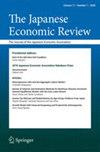公共债务、生产性公共支出和内生增长
IF 1.5
4区 经济学
Q2 ECONOMICS
引用次数: 8
摘要
我们在一个具有生产性公共支出的基本内生增长模型中分析了公共债务的影响。我们证明了在平衡增长路径上,自由裁量政策一般违反了跨期政府预算约束。平衡的政府预算提供了一条独特的鞍点稳定增长路径。在基于规则的政策下,根据消费替代的跨期弹性和基本盈余政策,可以出现两条鞍点稳定平衡增长路径。较高的债务伴随着较低的长期增长,我们得出这样一个条件:由赤字融资的公共支出增加会提高增长率。本文章由计算机程序翻译,如有差异,请以英文原文为准。
Public Debt, Productive Public Spending and Endogenous Growth
We analyse the effects of public debt in a basic endogenous growth model with productive public spending. We demonstrate that a discretionary policy in general violates the intertemporal government budget constraint along a balanced growth path. A balanced government budget gives a unique saddle point stable growth path. With a rule-based policy, two saddle point stable balanced growth paths can occur, depending on the intertemporal elasticity of substitution of consumption and on the primary surplus policy. Higher debt goes along with smaller long-run growth and we derive a condition such that a deficit-financed increase in public spending raises the growth rate.
求助全文
通过发布文献求助,成功后即可免费获取论文全文。
去求助
来源期刊

Japanese Economic Review
ECONOMICS-
CiteScore
2.70
自引率
0.00%
发文量
15
期刊介绍:
Started in 1950 by a group of leading Japanese economists under the title The Economic Studies Quarterly, the journal became the official publication of the Japanese Economic Association in 1959. As its successor, The Japanese Economic Review has become the Japanese counterpart of The American Economic Review, publishing substantial economic analysis of the highest quality across the whole field of economics from researchers both within and outside Japan. It also welcomes innovative and thought-provoking contributions with strong relevance to real economic issues, whether political, theoretical or policy-oriented.
 求助内容:
求助内容: 应助结果提醒方式:
应助结果提醒方式:


